After a leak was discovered in one of the International Space Station’s modules, which normally travels 400 kilometres above the Earth, astronauts were left scrambling to find a speedy fix in case things got out of hand.
During its 93-minute ride in Earth’s orbit, the space station usually leaks air from some of the modules. During its 15.5 orbits around Earth, the station loses more than 250 grammes (0.6 pounds) of air each day, but this isn’t always the case, as evidenced by this leak.
How astronauts aboard the International Space Station discovered the leak?
The station began to lose more than a kilogramme per day as the days passed. Typically, astronauts from the United States, Japan, Russia, Canada, and Europe are aboard the station. They were forced to search the station for the source of the leak when it occurred.
They locked all the modules and camped together in one of the International Space Station’s extreme end modules, Zvezda, in the Russian side of the station, to figure out where it came from.

Over the course of four days, they checked each piece of the space station for leaks. Unfortunately, their experiment failed miserably.
The astronauts soon realised that the model for which they had been waiting was the one that was leaking. The Zvezda module, which was launched in 2000, is particularly critical on the ISS since it protects the station’s life support systems in the event of an emergency.
The teabag has arrived!
Anatoly Ivanishin, a Russian cosmonaut, saved the day with a teabag in October 2020. The cosmonaut ripped open the teabag and sealed its doors after installing a few cameras in the Zvezda module. They saw the tea leaves gently float towards a minor scrape on the space station’s metal wall not long after.

It turned out that it wasn’t even a scratch! The astronauts discovered a crack through which air was fleeing the space station, which they plugged with tape and foam on the spot. According to Roscosmos, astronauts then entirely filled the hole using a drill and sealing material.
The International Space Station represents a significant financial investment. Before launching on November 20, 1998, it was built at a cost of up to $150 billion. The International Space Station requires roughly $3-4 billion in annual maintenance costs. Metal fatigue or tiny meteorites produced the flaws that were discovered in the station.




